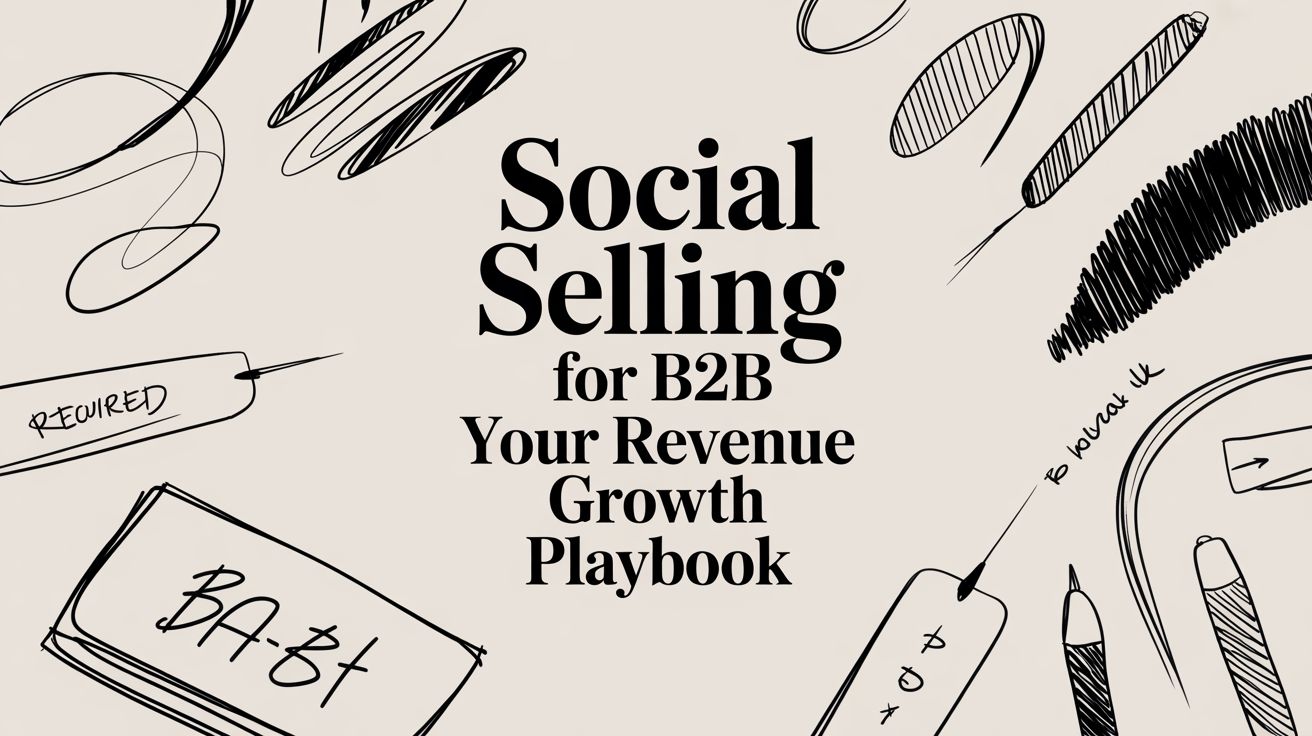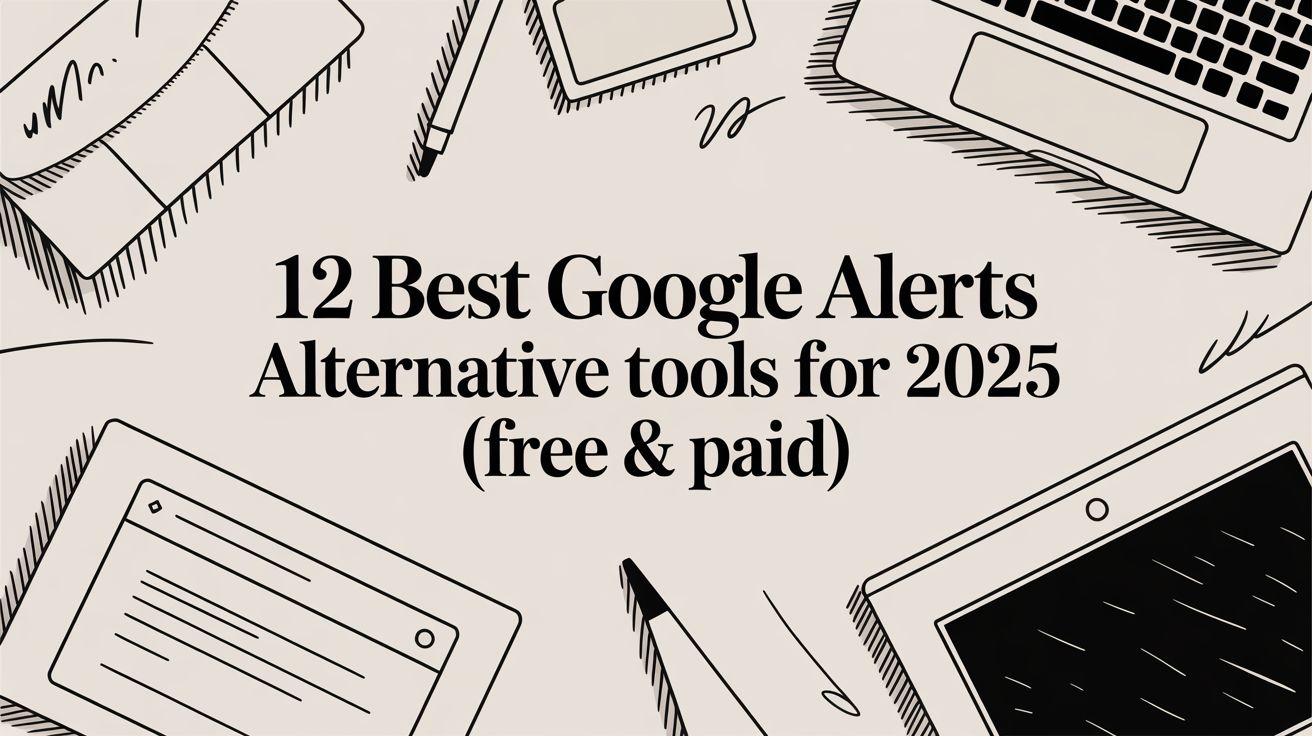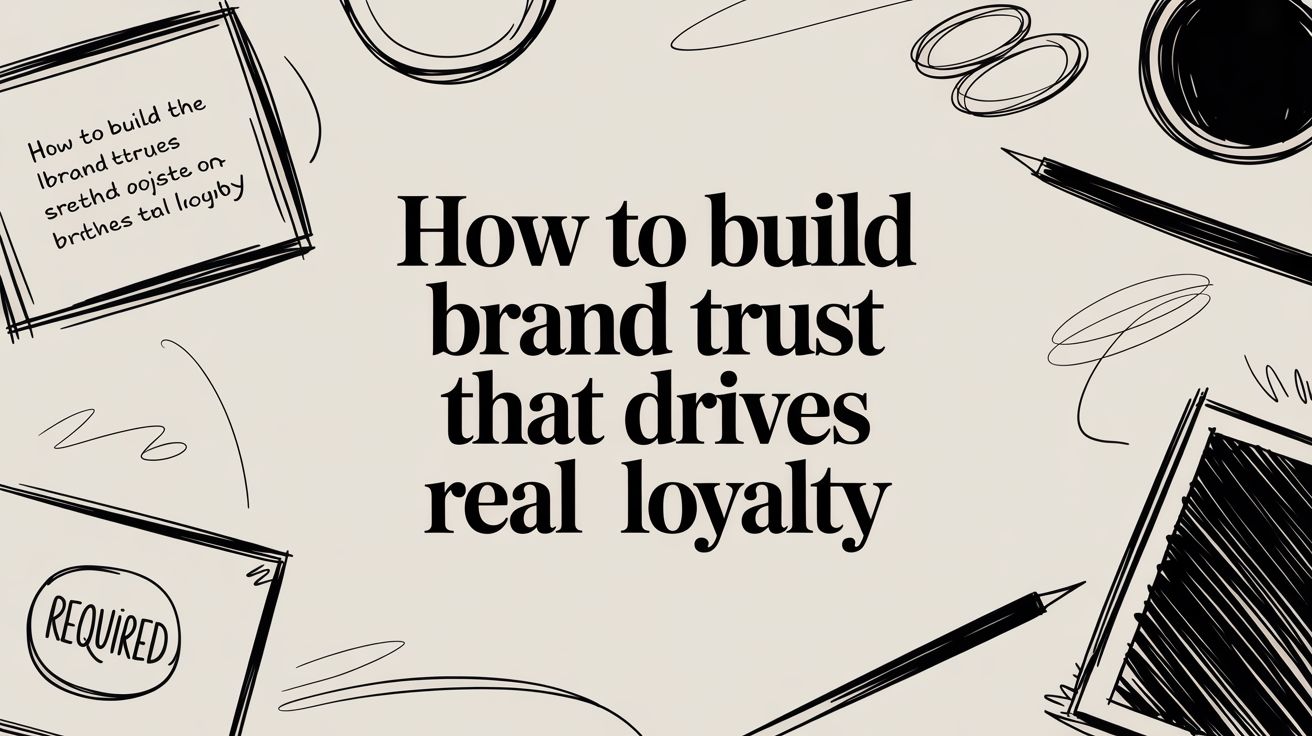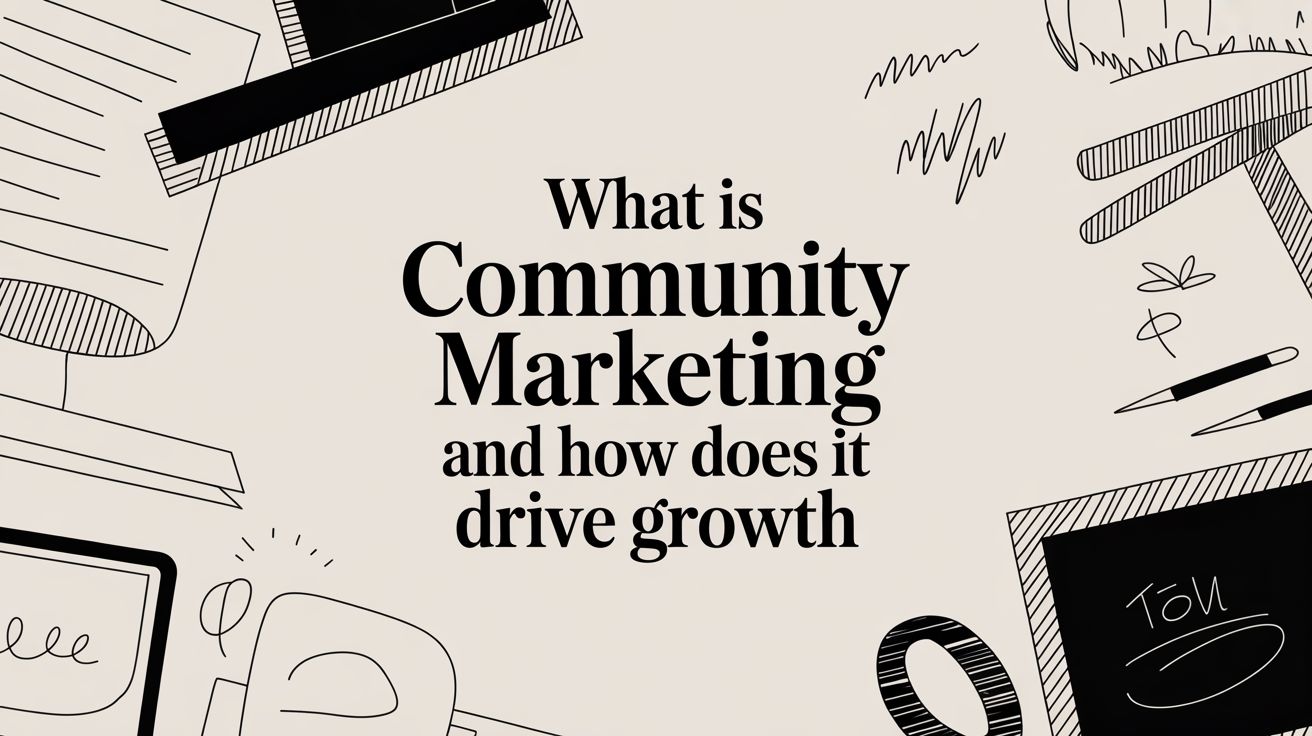Let's cut to the chase: social selling for B2B isn't some trendy new tactic. It’s the evolution of sales—a direct response to how modern buyers actually make decisions. It means ditching the aggressive, interruption-based methods of the past and instead using social media to find the right people, build real connections, and nurture those relationships with genuine value before you ever ask for a sale.
Think of it as moving from a cold, impersonal megaphone to a thoughtful, one-on-one conversation.
Why B2B Social Selling Is Now Standard Practice
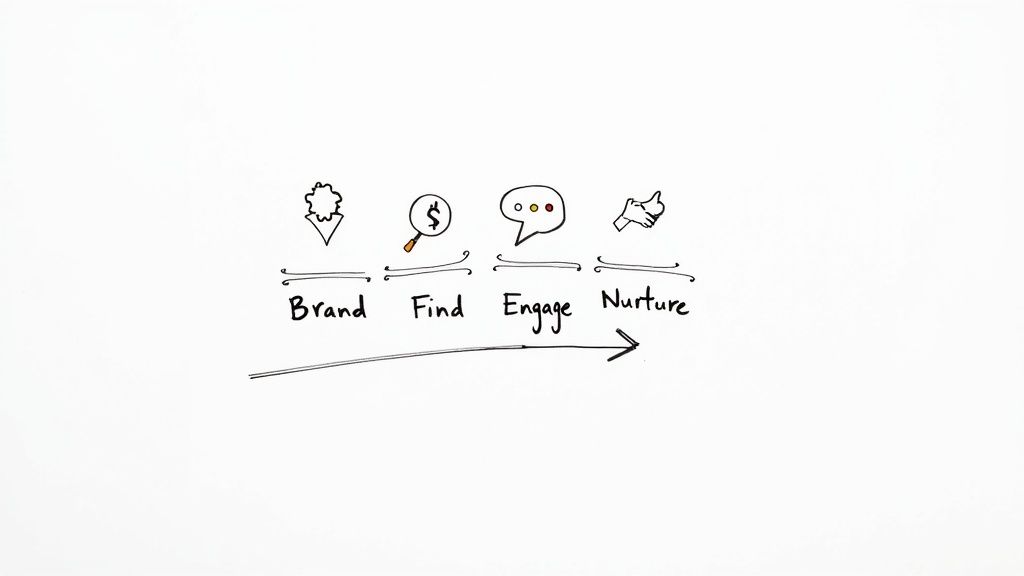
Honestly, the days of getting consistent results from cold calls and generic email blasts are fading fast. The B2B buying process has been completely flipped on its head.
Today's decision-makers are savvier, more self-reliant, and have a built-in filter for traditional sales pitches. They aren't waiting by the phone for you to tell them about your product; they’re already online, doing their own homework. This fundamental shift is precisely why social selling has become a core component of any serious B2B sales playbook.
To put this change in perspective, let’s look at the old way versus the new way.
The Shift from Traditional to Social Selling
| Attribute | Traditional Selling (Cold Calling/Emailing) | Social Selling |
|---|---|---|
| Approach | Interruption-based (unsolicited) | Relationship-based (permission) |
| Focus | Product features and immediate sale | Buyer's pain points and providing value |
| Timing | Seller's schedule | Buyer's journey |
| Communication | One-way pitch | Two-way dialogue |
| Key Metric | Volume of calls/emails | Quality of engagement |
| Buyer Perception | Annoying, intrusive | Helpful, credible resource |
This table really highlights the core difference: one is about pushing a message, and the other is about pulling in prospects through trust and expertise.
The Power Has Shifted to the Buyer
Before a B2B buyer even thinks about talking to a sales rep, they've already done a ton of research. They’re scrolling through LinkedIn feeds, following industry debates on X (formerly Twitter), and asking for advice in niche Reddit communities.
This means your first contact isn't the start of their journey—you're jumping in halfway through.
The numbers don't lie. A massive 75% of B2B buyers now lean on social media to help guide their purchasing decisions. And even more telling, an overwhelming 90% of top decision-makers say they simply don’t respond to cold outreach anymore. You can dig into more of these social selling statistics from recent industry reports.
The new rule is simple: You have to be where your buyers are. If they're vetting solutions on social media, your absence is a gift to your competitors.
Pillars of a Winning Strategy
A solid social selling strategy isn’t about just posting randomly or sending mass connection requests. It's a disciplined approach built on four key pillars that meet the modern buyer exactly where they are.
Build a Credible Brand: Your social profile is your new business card and digital storefront, all in one. It needs to scream "expert" and establish you as a trustworthy voice in your industry.
Find the Right Conversations: Stop interrupting and start listening. Pinpoint the discussions where potential customers are talking about the very problems you solve, and then join in.
Engage with Genuine Value: Offer advice. Share a helpful article. Answer a question without expecting anything in return. This is how you build rapport and become the first person they think of when they're ready to buy.
Nurture Long-Term Relationships: The ultimate goal is to cultivate a network of prospects who see you as a trusted advisor. That way, when a need arises, you're not just another vendor—you're their go-to solution.
By adopting this mindset, you naturally align your sales process with the buyer's journey. The result? A healthier pipeline, shorter sales cycles, and customer relationships that actually last.
Finding and Listening to Your Ideal Customers
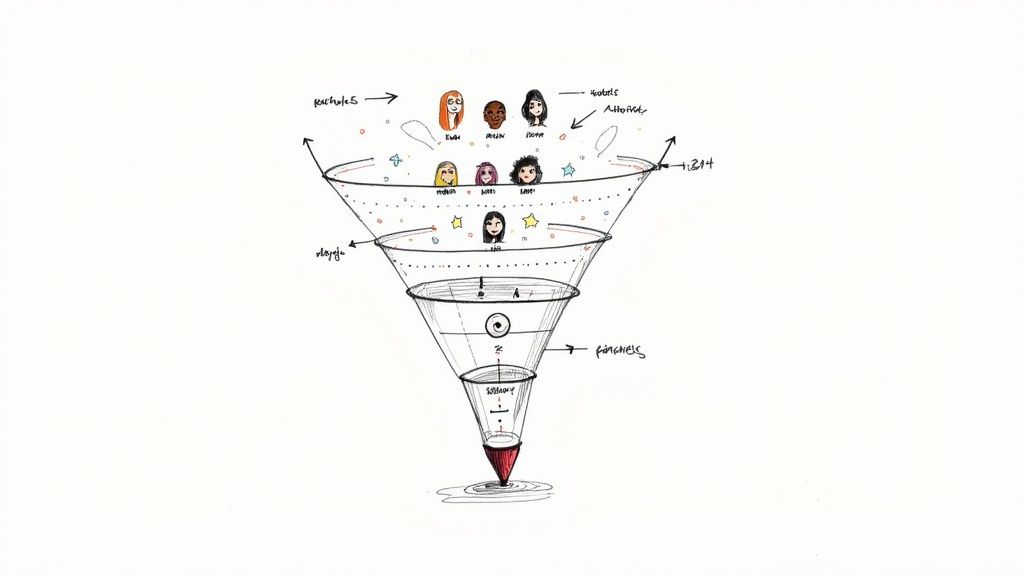
Great social selling for B2B isn't about shouting into the digital void and hoping for the best. It's much more surgical. Think of it as whispering the perfect piece of advice to the right person just when they need it. To get to that point, you first have to know exactly who you’re talking to and, even more importantly, what they’re already talking about.
This is where we leave guesswork behind and step into strategic intelligence. It all starts with a crystal-clear Ideal Customer Profile (ICP), which then fuels your social listening strategy, helping you pinpoint where your future customers are gathering online.
Go Beyond Basic Demographics
Most ICPs stop at the basics: job titles, company size, and industry. That’s a start, but in social selling, it’s just table stakes. To build a genuine connection, you have to understand the person behind the professional title.
Your social-centric ICP needs to answer more specific questions. Where do they actually "hang out" online? Which influencers do they follow on LinkedIn or X? What jargon and acronyms do they use when they talk about their work challenges?
A foundational step in finding and listening to your ideal customers is to effectively create buyer personas, guiding your social selling strategy with precision. This transforms a generic profile into a vivid picture of a real person with specific online behaviors.
Mapping out these digital footprints is the difference between aiming a fire hose at a crowd and having a direct, meaningful conversation with an individual.
From Profile to Pain Point Keywords
Once you’ve defined your ICP, the next move is to translate their problems into a list of "pain point keywords." Forget about your brand or product names for a second. This is all about the exact phrases your ideal customers type when they complain, ask for help, or search for a solution online.
Let's say you sell project management software to marketing agencies. Your keywords aren't just "project management tool." You need to get more specific and dig into their real-world problems.
- "managing client feedback"
- "scope creep is killing us"
- "alternative to Asana"
- "best way to track marketing campaigns"
- "agency workflow bottleneck"
These phrases are buying signals hiding in plain sight. Each one is a real-time opportunity to engage with someone who has a problem you can solve. For a deeper dive, check out our guide on how this process ties directly into learning how to generate B2B leads through targeted listening: https://replymer.com/blog/how-to-generate-b-2-b-leads.
Master the Art of Social Listening
Social listening is the engine that drives any successful B2B social selling strategy. It's the simple practice of actively monitoring social platforms for mentions of your keywords, competitors, and industry topics. This is how you find those conversations as they happen.
And you don't need a massive budget to get started. Many platforms have powerful search tools built right in.
LinkedIn Sales Navigator: Use its advanced filters to zero in on prospects who recently changed jobs, posted with specific keywords, or are active in relevant groups. A "job change" alert is a golden ticket—it often means a budget reset and a prime opportunity to introduce a new tool.
X (formerly Twitter) Advanced Search: This is an incredibly powerful free tool. You can search for keywords within certain date ranges, from specific accounts, or even filter posts by sentiment (e.g., finding someone "frustrated with our CRM").
Reddit Keyword Monitors: Tools like F5Bot or TrackReddit can send you an alert the moment your keywords pop up in relevant subreddits, like
r/saasorr/marketing. This lets you jump into a discussion at the perfect moment.
The goal here is to shift from passive scrolling to active opportunity hunting. By setting up these listening posts, you ensure you're one of the first to know when a prospect basically raises their hand for help. You get to lead the conversation and provide value long before a competitor even realizes an opportunity exists.
How to Genuinely Engage on Key B2B Platforms
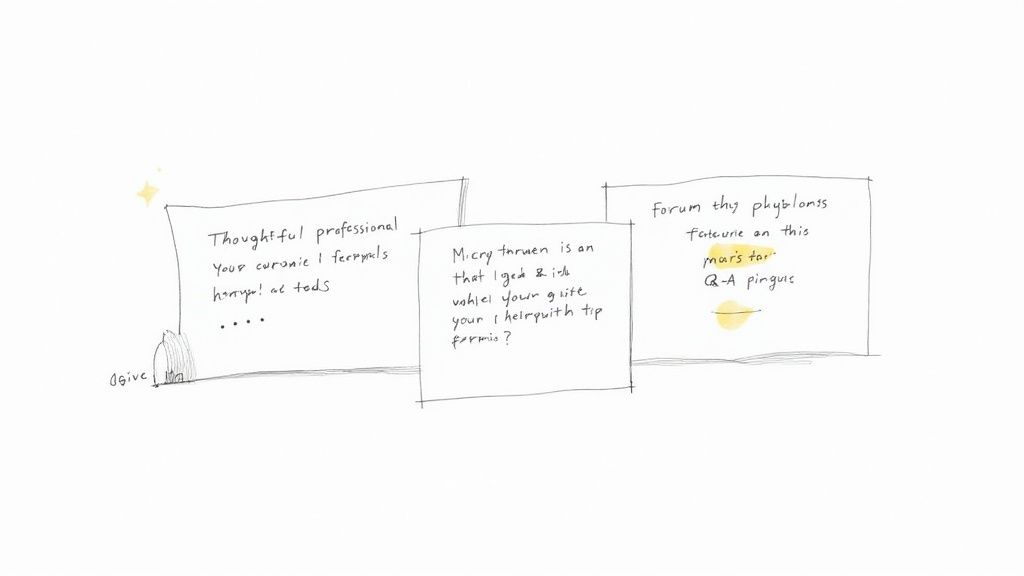
This is where the real work of social selling for b2b begins. You’ve done your listening; now it’s time to move from a silent observer to a valued contributor. The goal isn’t to jump in with a sales pitch. It’s to join conversations with genuine value, building trust and authority one authentic interaction at a time.
Each platform has its own culture and unwritten rules. What gets you noticed on LinkedIn will likely fall flat—or get you called out—on Reddit. To succeed, you have to tailor your approach to the specific environment. The guiding principle is always "Give, Give, Give, Ask." This means you need to be consistently generous with your insights long before you ever think about making a request.
This isn't just a "nice-to-have" strategy; it's a direct response to how modern B2B buyers think. They want to see expertise, not a direct sales pitch. The data backs this up. A 2025 survey revealed that 49% of B2B enterprises now have active social selling programs, incorporating everything from video content to participation in professional forums.
Mastering the Art of the LinkedIn Comment
LinkedIn is the main event for B2B professionals, but most people treat it like a chore. Just liking a post or dropping a generic "Great share!" is a complete waste of an opportunity. Your goal should be to write insightful comments that actually add to the conversation, get you noticed by the poster and their network, and subtly establish your expertise.
A high-value comment does more than just echo the original post. It might extend the point, offer a respectful counter-perspective, or ask a thoughtful question that keeps the discussion going. This simple act turns a passive interaction into a micro-demonstration of your knowledge.
Let’s look at a real-world example. Say an industry leader posts about the challenges of scaling a remote sales team.
- Weak Comment: "Totally agree!"
- Strong Comment: "This is a great point, especially regarding maintaining culture. I've seen teams find success with a 'virtual watercooler' Slack channel dedicated to non-work topics. Have you found specific rituals like that help bridge the distance?"
See the difference? The strong comment invites a reply and immediately positions you as a peer, not just another follower in the crowd.
Sharing Curated Content with Context
Sharing other people's content is a fantastic way to build your personal brand, but only if you add your own perspective. Never just hit the "repost" button and walk away. You have to add a few sentences explaining why you’re sharing it and what your main takeaway is.
Your commentary is what adds the value. It frames the content for your audience and connects the dots back to your area of expertise, reinforcing your position as a trusted curator of valuable information.
Always ask yourself, "So what?" before you share anything. That simple step transforms you from a content amplifier into a thought leader who helps people cut through the industry noise. It's a foundational piece of any solid B2B social media strategy, which you can dive into deeper with our guide on building a winning B2B social media strategy.
Joining Industry Discussions on X
X (formerly Twitter) moves incredibly fast, which makes it perfect for jumping into real-time industry conversations. The trick is to use relevant hashtags and create lists to find these discussions as they unfold. Don't just broadcast your own stuff; set aside time to reply to others with quick, helpful insights.
The platform's short format means your replies need to be concise and punchy. Answering a question, sharing a relevant stat, or linking to a useful resource (especially one that isn't your own) can quickly establish you as a go-to person in your niche.
If you really want to level up your pipeline management on LinkedIn, the most critical B2B platform, you should look into tools like LinkedIn Sales Navigator. Its advanced search filters and lead recommendations help you pinpoint the right people and conversations much more efficiently, so you know your engagement efforts aren't wasted.
Providing Genuine Advice on Reddit
Reddit can be an absolute goldmine for B2B leads, but it's famously hostile to self-promotion. The only way to win here is by offering genuinely helpful advice with absolutely no strings attached. Your goal is to become a respected member of a relevant subreddit, like r/sales, r/marketing, or r/startups.
Before you even think about mentioning your company or product, you need to put in the time—weeks, or even months—just answering questions and sharing your expertise.
- Find someone asking for advice on a problem you know your product solves.
- Write a detailed, thoughtful reply that gives them a complete solution, without ever mentioning your company.
- Only after you've built a solid reputation for being helpful can you subtly mention your solution in a relevant context. Even then, it must feel like a natural recommendation.
This long-game approach builds an incredible amount of trust. By the time you finally mention your product, the community is far more likely to see it as a genuine suggestion from a trusted expert rather than a spammy pitch. That authenticity is what makes Reddit such a uniquely powerful channel for generating high-intent inbound leads.
Proving the Value: How to Measure Social Selling ROI
So, you're putting in the hours—crafting thoughtful comments, sharing killer content, and building relationships. But how do you prove it’s actually working? To get buy-in (and keep your budget), you have to show that your social selling efforts are doing more than just earning likes. You need to connect those activities to the bottom line.
This isn’t just about justifying your time; it's about getting smarter. When you know your numbers, you know exactly where to double down and what to cut loose. It's about turning social chatter into signed contracts and proving it every step of the way.
Ditch the Vanity Metrics
Let's get this out of the way first: likes, shares, and follower counts aren't ROI. They’re nice, sure, and they can signal brand awareness, but they don’t keep the lights on. We need to focus on metrics that track real movement through your sales funnel.
These are the numbers that actually matter:
- New ICP Connections: How many new, qualified prospects from your Ideal Customer Profile did you connect with this month? This shows your network is expanding with the right people.
- Conversation Reply Rate: When you jump into comments or send a DM, what percentage of prospects actually write back? A high rate here is a great sign that your messaging is hitting the mark.
- Website Clicks from Social: Are people clicking the link in your bio or in the content you share? This is a crucial bridge between social engagement and your own turf.
- Qualified Leads Generated: This is the big one. How many conversations that began on a social platform turned into a booked demo or a genuine, qualified lead in your CRM?
Connecting Your Social Efforts to Real Revenue
The magic is in the attribution. You need a system that can trace a new customer all the way back to that first interaction on LinkedIn or X. A little bit of technical setup here pays off massively.
When you integrate your social media activity with your CRM, you get a single source of truth. Suddenly, you can see that the prospect who engaged with your LinkedIn post last week is now a high-value opportunity in your sales pipeline.
Here’s how to make that connection rock-solid:
- Embrace UTM Parameters: Whenever you share a link to your website or a landing page, tag it with UTM parameters. They’re just little snippets of code added to the URL that tell your analytics tools (like Google Analytics) exactly where that visitor came from (e.g.,
utm_source=linkedin&utm_medium=social&utm_campaign=q3_promo). - Sync with Your CRM: Make sure your CRM is set up to capture that UTM data when a lead fills out a form. Now you can run reports that show exactly how many leads—and how much revenue—came directly from your social selling. This is the ultimate proof.
This kind of tracking also shows you which platforms and posts are driving the best results, letting you fine-tune your strategy on the fly. To see how this fits into a bigger picture, our guide on social media for lead generation dives deeper into these tactics.
What Your LinkedIn Social Selling Index (SSI) Tells You
LinkedIn gives you a handy, built-in diagnostic tool: the Social Selling Index (SSI). It’s a score from 1 to 100 that gauges your effectiveness across four key areas. While it doesn't directly measure revenue, think of it as a health check for your social selling habits.
Your score is based on four pillars:
- Establish Your Professional Brand: How complete and customer-centric is your profile?
- Find the Right People: Are you using LinkedIn’s tools effectively to pinpoint prospects?
- Engage with Insights: Are you sharing valuable content and joining relevant conversations?
- Build Relationships: Are you successfully growing your network with decision-makers?
A low score in "Engage with Insights," for instance, is a clear signal to spend more time commenting and sharing. By regularly checking your SSI and working to improve each component, you’ll naturally boost the real-world results that matter most, turning your effort into measurable success.
Scaling Your Social Selling Efforts Effectively
So, you've got a good groove going. You're consistently listening, engaging, and sharing valuable content. But now you’ve hit a ceiling. How do you actually scale all this without losing the very authenticity that made it successful?
Scaling social selling for b2b isn't about logging more hours. It’s about working smarter, not harder.
The secret is to draw a clear line between the tasks a machine can do and the conversations only a human can have. Technology should handle the grunt work—the endless searching and filtering—so your team can focus on what they do best: building real relationships.
Building an Efficient Social Selling Workflow
A truly effective workflow knows what to automate and what to protect. You can’t automate a witty, insightful reply to a prospect's comment, but you can absolutely automate finding that comment in the first place.
Think of it like an assembly line. The machines do the repetitive, heavy lifting, but the skilled artisans add the final, crucial touches that create real value.
Here's how to build a workflow that scales:
- Automated Content Scheduling: Use a tool like Buffer or Hootsuite to schedule your content calendar. This keeps your brand present and active without you having to manually post every single day.
- CRM Integration: This is a non-negotiable. Connecting your social media activity to your CRM gives your sales team a complete picture of every interaction, from a simple "like" to a detailed DM. Context is everything.
- Templated (but Personalized) Responses: Create a few go-to templates for common questions. But—and this is critical—treat them as a starting point. Always personalize at least 20-30% of the message with details specific to the person you're talking to.
The Power of a Done-For-You Service
Even with the best tools, the daily grind of monitoring keywords, sifting through noise, and finding genuine opportunities is a massive time-suck. This is where a done-for-you (DFY) service can become a serious force multiplier for your sales team.
Why have your top closers spend hours scrolling through feeds when a specialized service can do it for them? It's simply a smarter division of labor.
A DFY service isn't meant to replace your sales team; it's meant to supercharge them. By outsourcing the time-intensive work of finding and warming up conversations, you free up your best people to focus on high-intent, pre-qualified leads.
A service like Replymer, for example, was built for exactly this. It scours platforms like Reddit, X, and LinkedIn for your keywords, identifies real buying-intent conversations, and has real humans craft helpful, non-salesy initial replies. They warm up the lead, and your team swoops in once the prospect is ready to talk business.
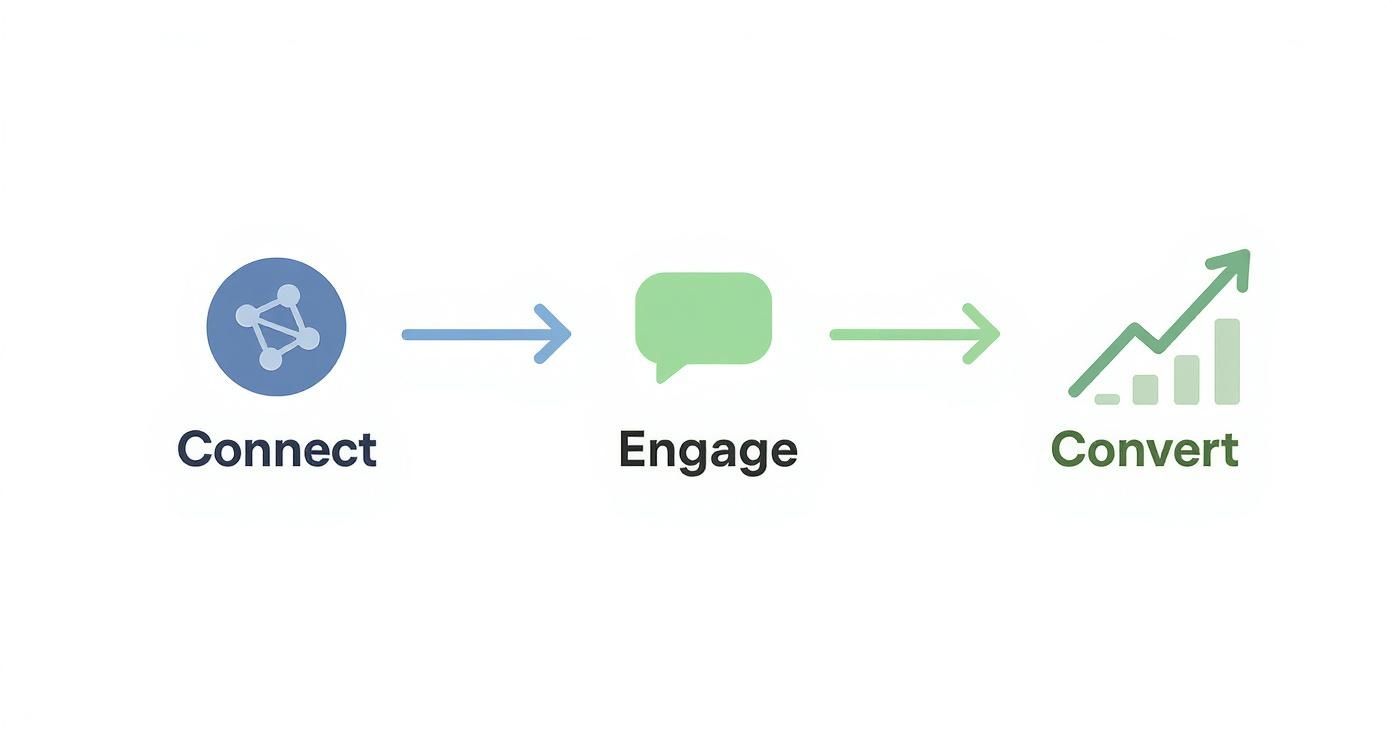
As the infographic shows, that initial connection is just the beginning. The real magic—and the ROI—comes from the genuine engagement that turns a random user into a loyal customer.
Making the Right Choice for Your Team
So, should you build an in-house process, lean on automation tools, or partner with a DFY service? The right answer really depends on your team's bandwidth, budget, and priorities.
Here’s a simple way to break it down:
| Approach | Best For | Primary Challenge |
|---|---|---|
| Manual In-House | Solopreneurs or small teams just getting started. | Incredibly time-consuming and almost impossible to scale effectively. |
| Automation Tools | Teams with the tech-savvy to set up and manage the software. | Can feel robotic if not managed carefully; still requires a human touch. |
| DFY Service (e.g., Replymer) | Teams focused on getting the highest ROI from their sales reps' time. | Requires a budget, but delivers the highest leverage and frees up your team. |
In the end, scaling social selling means you have to be ruthless about how your team spends its time. The most successful social selling for b2b programs intelligently protect their most valuable resource—their people—for the human-to-human interactions that actually close deals. Automate the search so your team can focus on the sale.
Answering Your Top Social Selling Questions
Whenever you're trying something new, questions are going to pop up. It's no different with B2B social selling. Let's cut through the noise and address some of the most common things that trip people up. Getting clear on these points can make all the difference between a stalled effort and a confident, effective strategy.
These aren't just theoretical answers; they're based on what we see working in the real world every day.
"How Much Time Do I Really Need to Spend on This Every Day?"
This is probably the number one question I get. The good news? It’s less about marathon sessions and more about building a consistent habit.
You don't need to chain yourself to your desk for hours. In fact, that's a fast track to burnout. Start with a focused 20-30 minute block each day. That’s it.
In that short window, you can realistically:
- Leave thoughtful comments on 3-5 posts from your target accounts or industry influencers.
- Share one genuinely useful piece of content (and add your own two cents).
- Scan your keyword alerts for any hot conversations you can jump into.
Consistency is what builds momentum. A little bit every day beats a frantic, multi-hour scramble once a week, every single time.
"But Can This Actually Work in My 'Boring' or Super-Technical Niche?"
Yes! And honestly, it often works better. When an industry is seen as "boring" or highly technical, it's almost always a wide-open field on social media. There’s so much less noise to compete with, making your expertise shine that much brighter.
Think about it: every industry, no matter how niche, has its own unique headaches, burning questions, and online watering holes where people gather to talk about them. Your mission is simply to find those places.
In a technical space, genuine expertise is your superpower. When you're the one who can break down a complex concept or offer a practical solution on a niche subreddit or a specialized LinkedIn Group, you instantly stand out as someone who knows their stuff.
"What’s the Biggest Mistake I Need to Avoid?"
This one’s easy: pitching way too soon. It’s the cardinal sin of social selling.
I get it. The temptation to connect with a promising prospect and immediately slide into their DMs with your sales pitch is strong. But it's also the fastest way to get ignored or blocked. You're trying to build a relationship, not just blast out a new form of cold email.
You have to earn the right to sell.
Always remember the "give, give, give, ask" philosophy. Offer up value—real value—over and over again. Answer questions, share resources, and provide insights with no strings attached. Be patient. That patience is what separates the true social sellers from the people who just come off as spammers.
Ready to scale your social engagement without spending hours searching for conversations? Replymer acts as your dedicated social selling assistant, finding high-intent discussions and crafting human-written replies to warm up leads for you. Let your sales team focus on closing deals, not scrolling through feeds. See how Replymer can help you.
